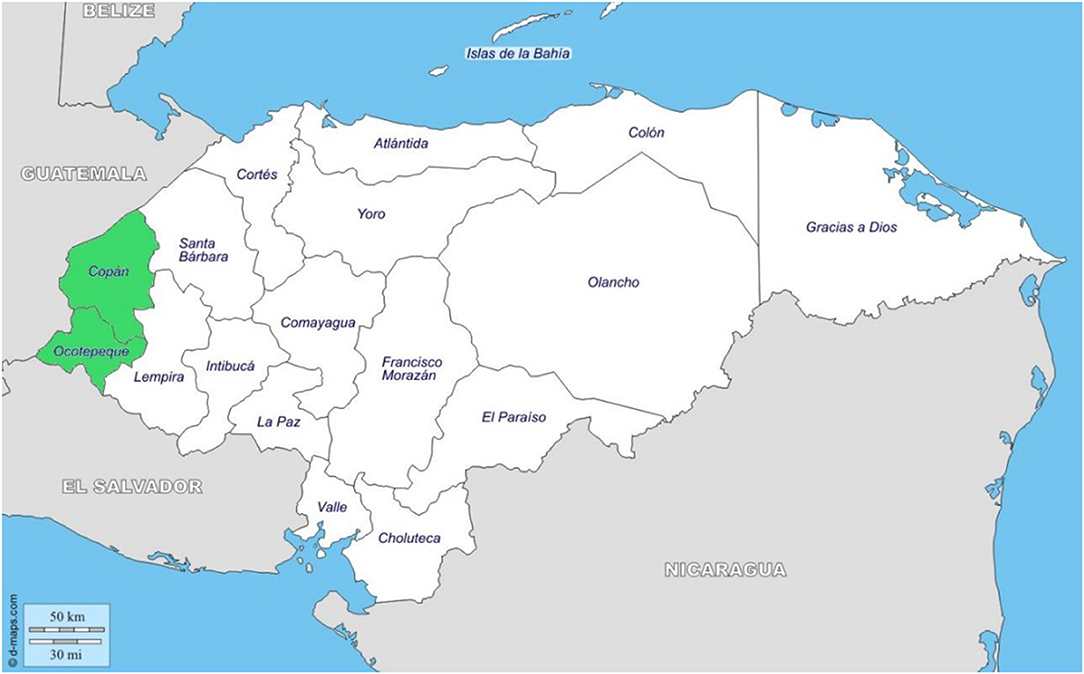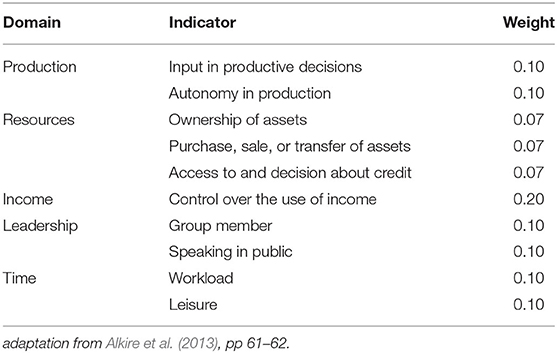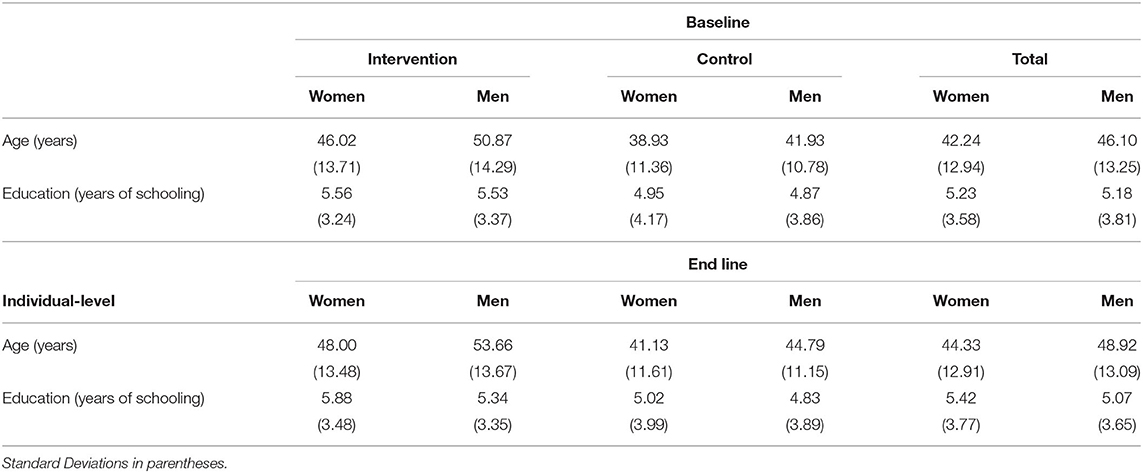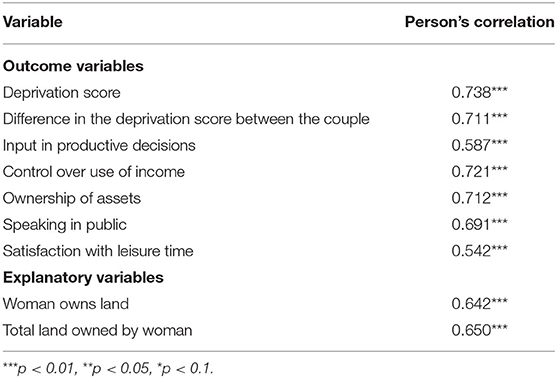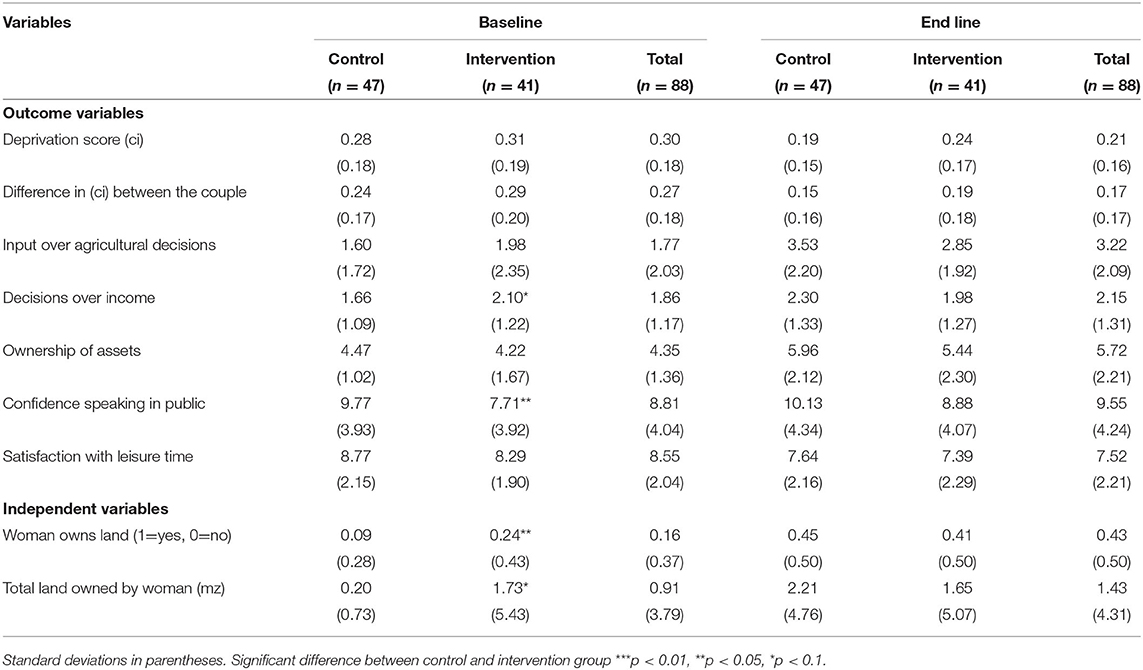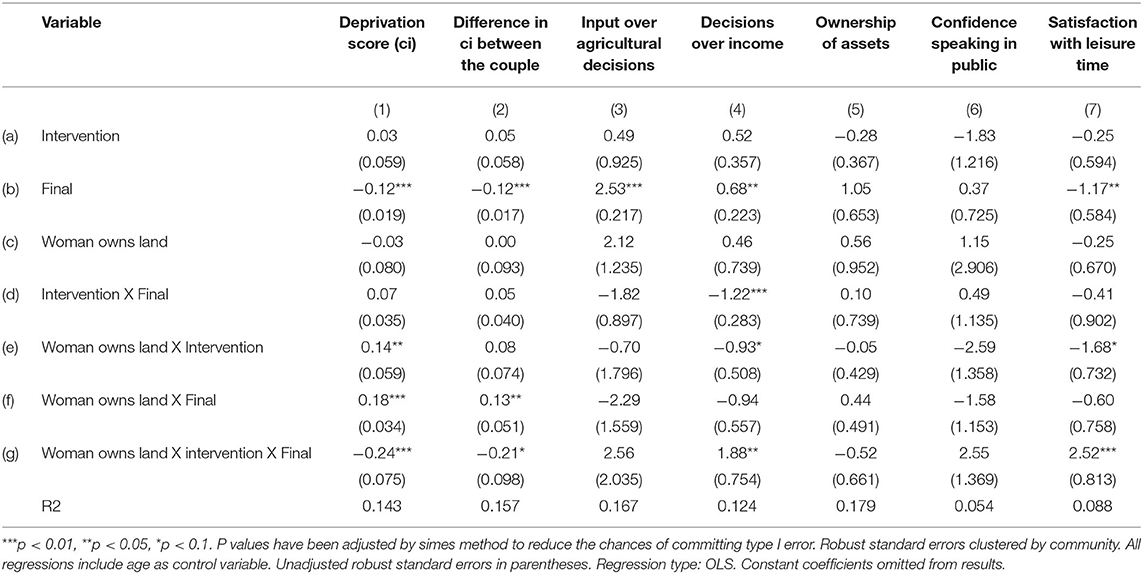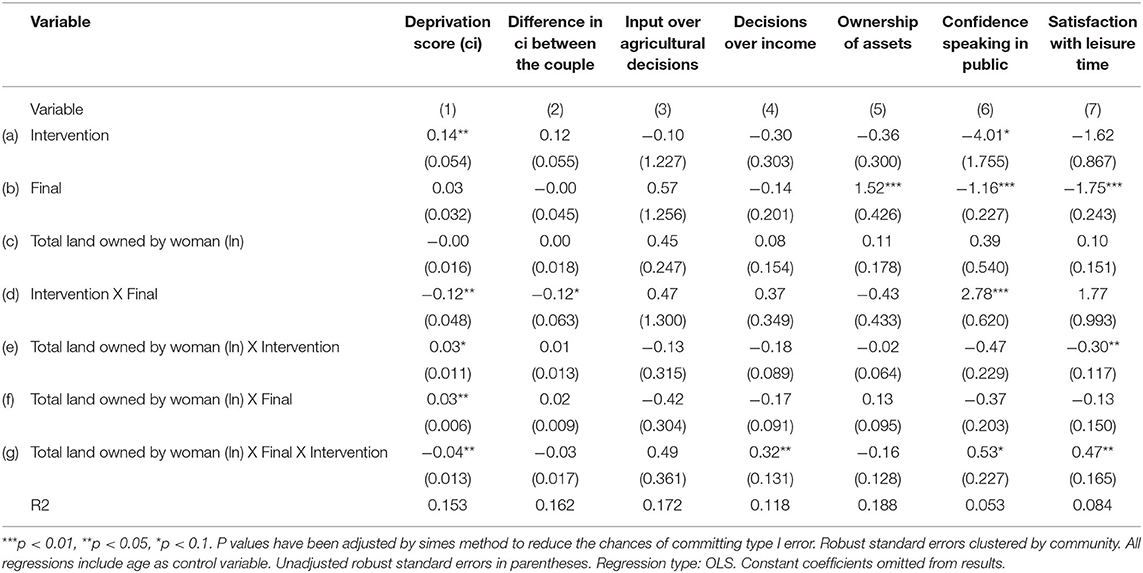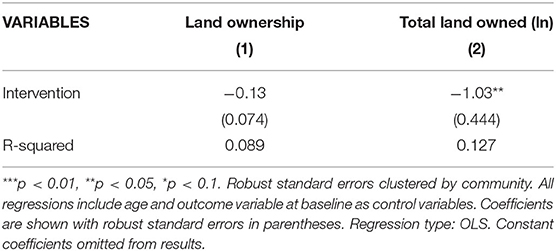- Institute of Political Science, Westfälische Wilhelms-Universität Münster, Münster, Germany
Latin-American coffee production has largely relegated women to specific family labor tasks, such as berry picking or cooking. But recent years have seen an increasing number of interventions to empower women in the agricultural sector, including coffee. As a contribution to the growing literature on women's empowerment in agriculture, this article draws on a randomized-controlled trial (RCT) to evaluate a gender empowerment project among coffee producers in Honduras. Previous RCT evaluations of gender empowerment interventions have focused on average treatment effects and paid less attention to the diversity of responses in the sample. This article evaluates the effect of a project to empower women in Honduras' coffee sector but pays attention to how the intervention interacted with the amount of land owned by women to produce different outcomes. The intervention consisted of 12 workshops offered to families in 10 coffee-producing groups. The baseline and end-line surveys (2016–2018) included a sample of 88 families (41 intervention and 47 control, from 4 to 5 communities respectively). Results showed limited effects of the intervention on women's empowerment for the pooled sample, but it found heterogeneous positive effects for land-owning women. Women who owned land and received the treatment scored fewer points on a deprivation score, had input over more decisions related to the use of household income, and were more satisfied with their leisure time. For quantity of land owned, this article also found positive heterogeneous effects for the same variables, and additionally for confidence speaking in public. Results suggest that projects to empower women might benefit from a more nuanced approach to the heterogeneity within the target population.
Introduction
Smallholder agriculture in Latin America is mostly controlled by men. Coffee is no exception, though it is well documented that women have an important role during the entire production cycle. Specifically for Honduras, about 50% of all labor in coffee farms comes from women (Álvarez, 2018). Although women provide a large share of labor in coffee production, they have almost no power over agricultural decisions and use of income within the household (Lyon et al., 2010).
Before moving forward, it is important to clarify the definition of women's empowerment used throughout this article. This article uses the following definition: “the expansion in women's ability to make strategic life choices in a context where this ability was previously denied to them.” These choices have three inter-related dimensions: resources, agency, and achievements (Kabeer, 1999). Access to resources and assets (as used in most of the cited literature and in this article) are also a useful proxy to measure agency (Alsop et al., 2006).
Recent years have seen a growing number of studies about women's economic empowerment in agriculture and its determinants. These studies suggest men own more and higher value assets than women, especially land, and that the ownership of these assets also affects household outcomes and investments (Doss, 2006; Meinzen-Dick et al., 2019). Evidence also suggests women's asset ownership and control matters for a range of development outcomes (such as children's educational attainment, investment in health, among others), for women themselves and their families (Olney et al., 2015; Johnson et al., 2016).
Despite this growing interest, the number of interventions to enhance women's empowerment in agriculture evaluated with randomized controlled trials is still limited, and existing evaluations have focused only on average effects (Das et al., 2013; Olney et al., 2015; Quisumbing et al., 2015; Johnson et al., 2016).
Das et al. (2013), for example, studied the impact on intra-household dynamics of the Bangladesh Rural Advancement Committee (BRAC) Poverty Reduction program in Bangladesh. Women from 6,919 selected households received productive asset transfers, training on the use of the assets, an allowance of about 175 Taka (around US $ 2.50) per week, periodic follow up, health support (such as free medical care), and social development initiatives (such as awareness-raising training). They found that the program, on average, increased women's sole cash ownership by 1,048 Taka. On the other hand, the program also increased males' sole ownership of seven out of the nine evaluated agricultural assets, compared to two assets for women, and in many cases considerably more than it increased female ownership of such assets. The program also reduced women's savings and spending decisions for food, housing, and healthcare. Roy et al. (2015) evaluated the same program and found that, in the case of agricultural productive assets, the program significantly increased men's sole ownership by about 375 Taka, while increased women's sole ownership by only 173 Taka.
Furthermore, a longitudinal RCT impact study implemented between 2010 and 2012 with 30 intervention and 25 control villages by Quisumbing et al. (2015), using before and after t-test for the intervention and control groups, found that men's ownership of assets increased more than women's in most cases and the gender-asset gap did not decrease. Specifically, men's ownership of cattle in the intervention group increased from 3.08 to 3.46 (p < 0.01) and for women it reduced from 0.23 to 0.20 (p = 0.1). The evaluated intervention included free vine distribution to members of farmer groups; trainings of farmer group members on Organic System Plan (OSP) cultivation; trainings of adult women in project households on the nutritional benefits of OSP; and trainings of farmer group members on marketing.
Additionally, a study presented by Johnson et al. (2016) including eight women's empowerment interventions in seven Asian and African countries (three of them evaluated with RCT methodology) found similar results. They found that these interventions significantly increased women's assets. However, at the same time, men's sole ownership of all other assets grew. For example, the evaluation's results of the Hellen Keller International's Enhanced-Homestead Food Production program in Burkina Faso by van den Bold et al. (2015) showed a significant increase in small ruminant and poultry ownership for both men and women, with a larger effect for men (4.4 vs. 2.6). The program aimed to improve maternal and child health and nutrition through an agriculture program targeted to women. The program included a transfer and training in agriculture and animal assets, and health and nutrition practices delivered through a behavior change communication strategy.
To start moving beyond average treatment effects and explore heterogeneity, it is useful to examine what observational studies of empowerment suggest about predictors. These studies suggest that important predictors of empowerment and therefore variables to consider when examining heterogeneous treatment effects include women's age and age difference between the couple (Mabsout and van Staveren, 2010; Bertocchi et al., 2014; Trommlerová et al., 2015; Anderson et al., 2017), women's education (Mabsout and van Staveren, 2010; Doss, 2013; Bertocchi et al., 2014; Alwang et al., 2017; Anderson et al., 2017), community and social norms and institutions (Doss, 2013; Anderson et al., 2017), and women's control over assets (including land) (Quisumbing, 2003; Mabsout and van Staveren, 2010; Doss, 2013; Sell and Minot, 2018).
Specifically for land ownership, the literature shows that men are more likely to own land than women, and their properties also tend to be larger than those owned by women (Deere and Leon, 2003). Women's land ownership also provides security in cases of husband's death or divorce, and studies find that women who own land or a house have increased opportunity to enhance their access to means to support their subsistence or livelihoods, independent of their husbands (Lyon et al., 2010; Grabe et al., 2015).
The aforementioned studies focus on average treatment effects and do not pay sufficient attention to differences between women. This article presents the results from a gender empowerment project among coffee producers in Honduras and tries to overcome limitations from previous studies by focusing on how land ownership interacts with interventions to enhance women's empowerment. As shown, owning productive resources has been found to strengthen women's bargaining position in the household (Quisumbing, 2003; Doss, 2013; Quisumbing et al., 2015; Anderson et al., 2017). Since land is an important, if not the most important productive resource, women's access to land is a key determinant of empowerment (Sell and Minot, 2018).
For this, the evaluation relied on a randomized controlled trial (RCT) at the community level. The gender empowerment project (hereafter referred to as “the project”) was part of a larger program aiming to strengthen local coffee producer groups in western Honduras. This program included technical, financial, and organizational training and support as well as the provision of economic resources to invest in the improvement of groups' infrastructure and logistics.
The gender project was implemented in 10 out of the 30 coffee producer groups participating in the program in the departments of Copan and Ocotepeque, Honduras1 (Figure 1). The project aimed to increase shared family responsibilities between women and men, increase the perceived value of women's contribution to farming, enhance women's leadership skills, and promote gender equity in the producer groups.
To achieve its goals, at the household level the project relied on 12 gender awareness workshops and the promotion of gender-sensitive practices with families through the implementation of the “Agents of Change” methodology, developed by the Gender Action Learning System (GALS, developed in 2002). The organization implemented these activities between 2016 and 2017. Workshops lasted about four hours each and were scheduled every one or two months, based on each group's time availability. Agents of change are trained couples who visit the community's households to provide follow up and advice to other couples to improve gender relations at the household and community level. At the producer group level, the intervention consisted of training of group members to include gender and intergenerational equity in their strategic and annual plans. Part of the broader strengthening program included the legal support to the 30 producer groups to complete the process of legally register the group with the corresponding national institution, consequently, the coordination groups were developed as part of this process.
Results from this study showed limited effects of the intervention on women's empowerment in agriculture for the pooled sample of women but found heterogeneous positive effects of the project for women owning land and the quantity of land owned. Over time, women who owned land and participated in the project scored 0.24 fewer points on the deprivation score (ci), showed a reduction of 0.21 points (p < 0.1) on the difference in the deprivation score (ci) between the couple, had input over 1.88 more decisions related to the use of income and scored 2.52 more points on the satisfaction with leisure time score. Regarding the quantity of land owned, for women participating in the project, a 10% increase in land ownership was associated to 0.391 fewer points on the deprivation score and 3.23 more decisions over the use of income. Also, a 1% increase in land ownership was associated to 0.53 (p < 0.1) more points on the confidence speaking in public score and 0.47 more points in the satisfaction with leisure time score.
The Honduran Context
Coffee is highly important for the Honduran economy; it is estimated that more than 100,000 families work in its production. Coffee represents 30% of the Honduran agricultural GDP and 5% of the total GDP (Álvarez, 2018).
By 2018, Honduras had a total population of 9.6 million, the average years of schooling was 6.6, similar for men and women. Gross national income (2011 PPP) was $4,258. (UNDP, 2020). Honduras has one of the highest rate of poverty in Latin America, with extreme poverty (< $1.90 a day per person) concentrated in the western region (Larson et al., 2019).
In Honduras, women's ability to generate income in the agricultural sector is constrained by their limited use and control of human capital and physical assets (Dietz et al., 2018). Consequently, women often depend on men's income, putting them at greater risk of poverty and giving them fewer opportunities in the labor market (Warth and Koparanova, 2012).
Materials and Methods
Sampling and Methods of Data Collection
The selection process to participate in the gender project included a random selection of producer groups from the 30 communities participating in the broader program. Out of the 10 selected groups, four were randomly selected as part of the sample. The total control group was formed by the remaining 20 producer groups not receiving the gender component. Out of these 20 groups, five were randomly selected to be part of the control group sample (Figure 2).
For the last step, all households that were actively part of the selected farmers' group and in which a couple cohabited were interviewed, therefore excluding mono-parental households and single group members (Dietz et al., 2018). The final panel sample included 41 households in the intervention group and 47 households in the control group (Table 1). As communities differ in size, it was necessary to include one extra control community to ensure a similar total number of households for the two samples (control and intervention).
In addition to the household surveys, and being aware of the possible limitations derived from the small sample, the evaluation included also qualitative data collection. Specifically, it included interviews with one management team from the intervention group and one from the control group. Besides, two separate focus groups (one with men and one with women) were carried out with the intervention group. This qualitative information was used to triangulate results from the quantitative analysis derived from the surveys.
Ethics
As the evaluation of the project included the collection of primary data from participants, the protocol was reviewed and approved by the Scientific Advisory Board of the University of Muenster in Germany. This board is responsible of verifying that all research projects developed by the University comply with its technical and ethical standards. Besides, the farmers participating in the survey also provided their informed consent to participate in this study.
Statistical Analysis
The analysis had two main goals. The first one was to measure the overall impact of the project on women's empowerment using a difference-in-difference estimator. The second goal was to explore the heterogeneous treatment effects (HTE) of the project based on two variables measuring women's land ownership: ownership of land as a binary variable and total land owned by women.
Impact evaluation literature supports the use of HTE to get a better understanding of the different size of the effects based on participants' characteristics. Gabler et al. (2009) emphasize that the use of exploratory interaction analyses can be useful to generate new hypotheses regarding moderators of treatment effects. Furthermore, the finding of significant heterogeneous effects (as the ones shown in this article) could be used for future researchers to perform adequately powered confirmatory studies. In the development field, HTE can be used to better focalize interventions, and increase efficiency in the use of resources, and consequently, in the achievement of goals.
Variables
Outcome Variables of Empowerment
The outcome variables to measure women's empowerment are based on the questions used to construct the 10 indicators part of the Women's Empowerment in Agriculture Index, WEAI (Alkire et al., 2013). The Index groups the indicators in five domains of women's empowerment. Table 2 summarizes the indicators and the weight used by Alkire et al. (2013) to calculate the deprivation score (explained below). A full detail on the creation of the score and each one of the 10 indicators can be found on the IFPRI website (IFPRI, 2021).
This article includes the analysis for five of the 10 indicators used to construct the WEAI: (1) input in productive decisions, (2) ownership of assets, (3) control over the use of income, (4) speaking in public, and (5) leisure. Besides, the analysis includes the deprivation score of the index and the difference in this score between the couple. Below is the description of each one of these variables2:
- Deprivation score: The inadequacy score of each person is calculated by summing the weighted inadequacies experienced by the subject for the 10 indicators above mentioned so that the inadequacy score for each person lies between zero and one. The score increases as the number of inadequacies of the person increases (Alkire et al., 2013).
- Difference in the deprivation score between the couple: Based on the deprivation score defined previously, this indicator measures the difference in the deprivation score between the couple (woman minus man's deprivation score). Positive values indicate higher empowerment of the man in the couple. Negative values indicate higher empowerment of the woman.
- Input in productive decisions: This indicator is based on nine questions examining two main points related to the family agricultural production. The first is whether the individual has participated in the agricultural activity, how much input they feel they have in decision-making. Second, to what extent does the individual feel they can make their own decision regarding aspects related to the family agricultural production. This variable summarizes the total number of questions the individual was empowered. It can take values between 0 and 9.
- Ownership of assets: Based on 14 assets this indicator measures how many assets the individual reported having joint or sole ownership. It can take values between 0 and 14.
- Control over the use of income: This variable is constructed from answers to eight questions regarding input into decisions about the use of income in different household activities. It measures how many activities the individual was empowered to decide on the use of the income generated by that activity. It can take values between 0 and 8.
- Speaking in public: The indicator for whether the individual is comfortable speaking in public is constructed based on responses to questions regarding the individual's ease in speaking up in public in three different contexts. The scale for each question goes from 1 to 5, where 1 is totally uncomfortable and 5 is totally comfortable. The indicator is the sum of the scores for the three questions and takes values between 3 and 15.
- Leisure: Respondents were asked to rank from 1 to 10 their level of satisfaction with the time available for leisure activities, where 1 is totally unsatisfied and 10 totally satisfied.
Independent Variable: Land Ownership
As mentioned earlier, to measure land ownership this evaluation used two variables. The first is a dummy variable that takes the value of one if the woman owns land, and zero if not. The second variable is the quantity of land owned by the woman, measured in the local land measurement unit “manzanas” (mz) 3 expressed as natural logarithm4. It is also important to note that the variable used includes joint or sole ownership, which, as seen previously, does not imply the woman's equal authority in decision-making compared to the man. This article used two explanatory variables measuring ownership of land to increase the robustness of the results and to take into account not only ownership but also a measure of wealth, that is better captured by the quantity of land owned. The selection of land ownership as the main explanatory variable to measure heterogeneous effect is based on evidence supporting that in places where agriculture is the main source of income, increasing women's land ownership has the potential to increase their power within their relationship, as well as women and household's welfare (Grabe et al., 2015; Mishra and Sam, 2016).
Results
Table 3 shows the results from regressions of receiving the intervention as the outcome variable (1 = yes, 0 = no) against main determinant indicators at the coffee producer group level, such as average community age, education, total land, and number of assets owned by the household to prove the orthogonality of the treatment on some of the main determinants of empowerment mentioned in the previous section. Regressions were run separately given the small sample size of communities (n = 9). The only difference between groups with a significant result (p < 0.05) was age, where being in the intervention group was correlated to 0.06 more years. This variable was used as control in all the following regressions.
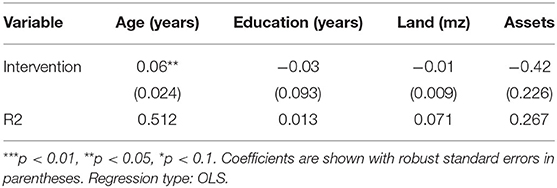
Table 3. Independence of the randomization against measurable determinants of empowerment at the coffee producer group level (n = 9).
Descriptive Statistics of the Sample
Table 4a summarizes the basic descriptive statistics of the sample at the household level at baseline and end line. At baseline, on average, the control group had 13.49 mz of land, and the intervention 12.02. The average quantity of land remained relatively constant, with a reduction of about 1.2 “manzanas” in the control group (from 13.49 to 12.22). At baseline, households in the intervention group owned 7.91 different type of assets against 8.27 in the control group. Both groups increased by about one type of asset by end line.
Table 4b summarizes descriptive statistics at individual level, by sex. The average age for women in the intervention group at baseline was 46.02, while it was 38.93 in the control. Neither group had more than six complete years of education. Intervention and control groups did not differ significantly in the most relevant demographic variables of empowerment such as years of education, and age difference between the couple (not shown). However, they significantly differed in average age, with the control being slightly younger than the intervention (Table 4b).
The autocorrelation test carried on before moving forward with the statistical analysis showed high correlation between the baseline and end line samples for the outcome variables (Table 5). Based on (McKenzie, 2012), when outcome variables show high autocorrelation, a baseline-end line model is more appropriate. Regardless of this finding, this article includes also ANCOVA regressions as a robustness check.
Table 6 summarizes the descriptive statistics for the outcome and independent variables. At baseline, there is difference of about two points on the confidence speaking in public index, with the control group showing a higher value (p < 0.05). There is also statistically significant difference on the percentage of women owning land (p < 0.05), with 24% of women owning land in the intervention group and only 9% on the control group.
Average Treatment Effect and Heterogeneous Treatment Effect
Tables 7a–d present the results for the seven outcome variables (columns 1–7). Table 7a presents the basic model to evaluate the intention to treat for the pooled sample. The second model in Table 7b presents the average treatment effect or difference-in-difference. Model in Table 7c presents the heterogeneous effects for women owning land (dummy variable) and Table 7d presents the HTE of the project based on the quantity of land owned by women (in a logarithmic form). Significance levels are adjusted for multiple testing for models 7b to 7d.
Model (a) summarizes the intent-to-treat estimators using OLS regression for the pooled sample of women. Results show no significant effect of the project for any of the seven studied outcomes. Model (b) shows the average treatment effect of the project on women. Results show no significant effect of the project on six out of the seven outcome variables studied. Column (4) shows a significant effect (p < 0.01) of the project on the decision over income. Participating in the project was associated to 0.76 fewer decisions over income compared to those women not participating.
The lines in Tables 7c,d goes from (a) to (g), with the coefficient of interest for the HTE over time of land ownership interacted with participation in the project on line (g). For Table 7c it is interpreted as the incremental effect of owning land for women participating in the project. For Table 7d this represents the multiplying effect over time of the quantity of land owned by women participating in the project.
Model (c) presents the HTE of the intervention conditional on women's land ownership. For women participating in the project, owning land was correlated to 0.24 (p < 0.01) fewer points on the deprivation score [column 1, row (g)]. It also reduced the gap on the deprivation score between the couple by 0.21 points (p < 0.1). For women participating in the project, owning land also increased the number of decisions over income by 1.88 (p < 0.05) more decisions over income taken [column 4, row (g)] and 2.52 (p < 0.01) more points on the satisfaction with leisure time score [column 7, row (g)].
Model (d) also shows a positive correlation between the quantity of land owned by women participating in the project and four outcome variables. A 10% increase in land ownership over time was correlated to 0.391 (p < 0.05) fewer points on the deprivation score [column 1, row (g)], and to 3.23 (p < 0.05) more decisions over income [column 4, row (g)]. For women participating in the intervention, this model also shows a positive correlation of total land owned with their confidence speaking in public [column 6, row (g)], and with their satisfaction with leisure time [column 7, row (g)]. For the first one, a 1% increase in land ownership over time was correlated to 0.53 more points on the confidence speaking in public score (p < 0.1), for the second one, 1% increase in land ownership was associated to 0.47 more points (p < 0.05) on the satisfaction with leisure time score.
Project Participation and Women's Land Ownership
Results show a significant negative association of participation in the project and land ownership, as well as with the quantity of land owned by women participating in the project (Table 8). Participating in the project was associated to a reduction of 0.19 on the probability of owning land (p < 0.05), and 1.4% on total land owned (p < 0.01) compared to women in the control group. As shown on Table 6, most of the observed difference over time comes from a higher increase in land ownership from the control group, even when both groups showed increase on the number of women owning land. For the intervention group, even when there was an increase in the percentage of women reporting owning land, there was also a reduction in the average quantity of land owned from baseline to end line (Table 5).
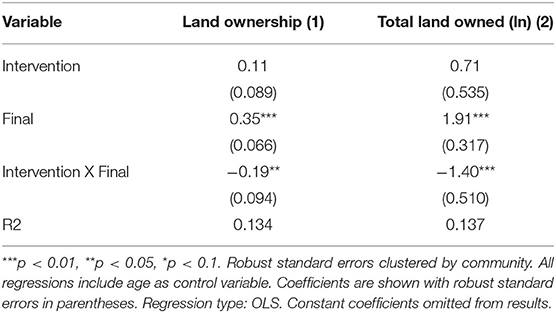
Table 8. Project's impact on main explanatory variables (n = 176): difference-in-difference estimates.
Robustness Analysis: ANCOVA Regressions
McKenzie (2012), following the findings of Vickers (2003), suggested that the use of ANCOVA regressions is more convenient than the traditional baseline-follow up scheme when the expected autocorrelation of the outcome variables is low. As a robustness analysis, this article includes also ANCOVA regressions for all the models, even when correlation for the outcome variables is high (Table 3).
This robustness analysis was carried out for the intention to treat on outcome variables (Table 9) and independent variables (Table 11), as well as for the HTE regressions of women's land ownership (Table 10a) and total land owned by women (Table 10b). Significance levels for Tables 10a,b are adjusted for multiple testing. All variables at the right of the regression model are values at baseline. These regressions include also the outcome variable at baseline as a control.
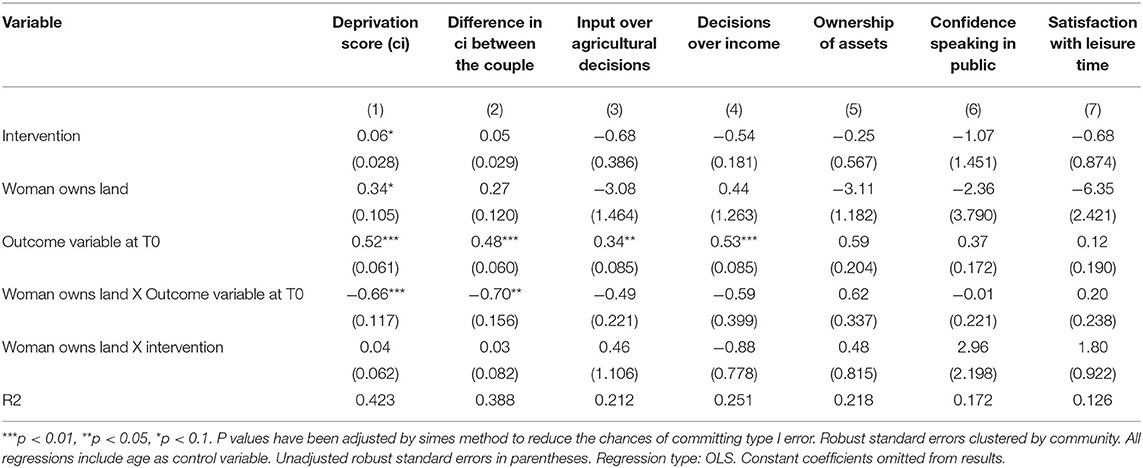
Table 10a. ANCOVA regression: results from heterogeneous treatment effect of land ownership (n = 88).
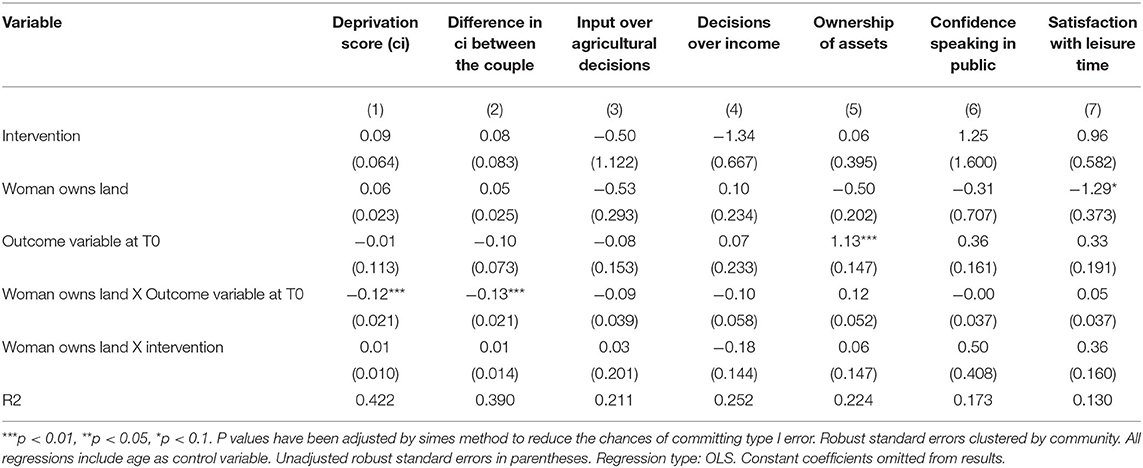
Table 10b. ANCOVA regression: results from heterogeneous treatment effect of total land owned by the woman (log) (n = 88).
For the intention to treat regression, similarly to the findings on average treatment effect (Table 7b, column 4), results showed a significant negative association of project participation and decisions over income (Table 9, column 4), participating in the project was associated to 0.51 less decisions (p < 0.05). No statistically significant results were found for HTE (Tables 10a,b, last row).
Mirroring the results from the previous regressions, regarding the relation between project participation and the explanatory variables (Table 11). This analysis found a significant negative association. Participating in the project was negatively (−1.03, p < 0.05) associated to the total quantity of land owned by women (Table 11, column 2).
Limitations
The evaluation presented in this article has three main limitations. The first one is the limited sample size. Power analysis of the sample (not shown), showed that, indeed, the study might have benefited from a larger sample, but reasons for the lack of significant results in the difference-in-difference analysis might also be related to other not observed factors. Qualitative analysis also support the quantitative results, for example, it was not possible to identify significant changes in the discourse of women and men participating in the focus groups regarding the gender relations and balance of power at household level in the intervention communities.
The second is the limited time of the intervention. As mentioned before, this project tried to implement the “Agents of Change” methodology developed by the Gender Action Learning System (GALS), unfortunately, in some communities the agents of change training ended at almost the same time as the project completion, precluding the possibility of proper follow up in the field. This limitation might not have significantly changed the results of the project at household level, as one of the agents of change couples reported that they did not perform the visits to other households, even after completing the training, as they felt other members could perceive it as too intrusive. This methodology has been proven effective in other contexts, but in this specific area of Honduras the cultural tradition of household privacy and autonomy might imply great difficulties for implementing this methodology.
The third one is the lack of individual records of assistance to trainings, as a result, it was not possible to measure compliance with the treatment at individual level, making this a limitation for a better understanding of the results. Despite this fact, this might not represent a significant threat to the validity of the results, as the organization kept records of the intervention at group level, besides, high level of absenteeism to the trainings were discarded by groups members and project technical staff. At community level, all groups received the full intervention. Consequently, it is expected that this factor could not be the main determinant for the observed outcomes.
Discussion
This section discusses some possible explanations for the findings from the RCT, complemented by evidence from the qualitative analysis and revised literature. It includes one section to analyze the most relevant findings from the qualitative data; one section for the effects of the intervention over women's economic empowerment triangulated with the qualitative findings; a section with hypotheses to explain the lack of significant findings at the average level, and a final section of recommendations based on these findings.
Qualitative Evidence
Even when quantitative evidence did not show significant changes in most gender roles at the household level, at the organizational level one observed some changes. The interviewed management team from the intervention organizations all included women (though not as president or vice-president), this was not the case in the control community, where women were not part of the management team. It is important to notice that the current management teams were formed during the timeframe of the project, consequently, it is expected that their formation might have been influenced by the project.
Furthermore, intervention communities recognized the importance of considering women's opinions for organizational decision-making, mainly because they expressed that “women's opinions bring another perspective to the team.” In the control group, women's participation at the organizational level was limited to cooking and serving meals during the meetings, as expressed by leaders.
Women from intervention communities participating in the focus groups expressed some attitudinal changes in their husbands, but they were marginal compared with the ambitious goals of the project. They expressed that men already “bring the laundry to the basket” or “help cleaning the house.” No change was found regarding acknowledging the importance of reducing the gender assets and income gap. Women participating in the training also expressed more confidence when speaking in public, although quantitative evidence does not support this finding for the whole sample.
Effect of the Project Over Women's Economic Empowerment and Qualitative Evidence Supporting the Findings
This article found a negative correlation over time between participating in the project, with ownership of land and total land owned by women. This negative result comes, from one side, from a higher increase on the percentage of women reporting owning land in the control group. On the other side, from an increase on the average land owned by women in the control group, and a reduction in the intervention group (from 1.73 to 1.65 manzanas).
Going back to the qualitative results to try to understand these findings, an interesting reasoning emerged from the interviewed men. When talking to leaders of the organizations participating in the project and questioning them about women's rights in land ownership, the threat of separation emerged as an issue, as a man expressed “If we put the land under her name, if we split, then her new man will own our land.” They also expressed that separation would be easier for women if they owned land. Table 7b also showed negative results of the project for decisions over income (−0.76, p < 0.01). The project might have also increased the alertness of men regarding women's autonomy, causing a backlash. These findings match some of the literature cited in this paper (Quisumbing et al., 2015; Roy et al., 2015), showing ambiguous results from projects over women's economic empowerment.
Similar results were shown by Johnson et al. (2016), related to access and control of income. Doss et al. (2018) concluded that the intention of projects of altering power dynamics into the households can lead to backlash against women, if not addressed properly. Results from this article cannot confirm this point, but they suggest the presence of the aforementioned backlash. Results from the interviews still show unwillingness by men to share control over assets with women, as this might increase the latter's autonomy and independence.
Moving the discussion beyond the backlash effect, there is an alternative explanation for the findings related to decisions over income. The questionnaire measures self-perceived participation on decision-making over income. Therefore, it is possible that women participating in the project (as a result of the intervention) became more aware of their desired level of participation in the decision making process, and even when their participation increased in the practice, they perceived it as insufficient. This dissatisfaction would have been reflected on lower self-reported scores, even if their situation improved over time, affecting negatively the results, even if women's participation was actually increased. Further analysis is necessary to clarify this point.
When asking men in the intervention groups how the project could increase women's enrollment and participation in the leadership positions, two main topics related to institutions and norms emerged: one related to organizational rules and other related to cultural norms of use of time and division of labor at the household level.
The first issue was related to the organizational norm requiring each member of the group to give a certain amount of money to join the organization. As women, in most cases, are not receiving income directly from the coffee production, meeting this requirement is difficult, if not impossible, imposing a barrier for them to join the group. Men in these groups suggested a reform in the group's policies, which might allow women to join the organization jointly with their husbands under the same payment. This would allow women to have legal participation in decision-making positions and to vote during the members' yearly assembly. This recommendation is aligned with FAO (2011) and UN WOMEN et al. (2015) recommendations, which highlight the importance of making women's voices heard through meaningful representation in organizations.
This type of change cannot occur with an intervention focused only at the household level, therefore the inclusion of interventions to change institutional rules and norms is key. Including women's participation at this level could allow them to directly present their needs and prioritize them in the group's decisions and investments. Access to land could also provide women with more access to income generating activities, reducing the barriers to join the producers' organizations independently from their husbands. From here the importance of including women's wealth into the analysis.
The second topic was women's use of time. Men expressed that “women are too busy with household chores and child-rearing to participate in productive or community activities”. This study found no effect of the project on changing women's or men's use of time for work or domestic activities, but found that participating in the project was associated to 1.31 more hours of rest for women (p < 0.05, results not shown). Even when this result was significant for the whole group of women participating in the project, this evaluation only found a significant effect of the project on satisfaction with leisure time conditional to land ownership.
Possible Reasons for Limited Significant Results
The lack of quantitative evidence of changes in women's decision making and use of time at the household level might be explained by the following factors: (1) control communities might have also received through other organizations, interventions related to gender equity, as results show also positive changes in the control communities over time; (2) the power of the sample was not enough to measure the change; (3) the time of intervention might have been not enough, or not all participants received the intended package of interventions equally.
Development projects, especially when implemented by small organizations, suffer constraints in time and budget, measuring and documenting what is achievable with projects like the evaluated in this article is important in order to better allocate resources for future interventions. This possible non-compliance at individual level with the planned intervention is common in development projects and programs, especially for those targeting women and men in rural areas, since generally a missed day of work is one day without income. Consequently, effective strategies have to compensate for these “missing dosages” and become more creative in the way they will deliver the message, beyond the traditional training.
As explained before in the limits section, none of these factors represent a serious threat to the validity of the results, as qualitative findings support the quantitative results, and these findings are also aligned with previous literature.
Recommendations
In the development sector the implementation of similar projects (regarding constraints in time and budget) are common, consequently their rigorous evaluation is important, in order to measure the actual impact that can be achieved with these limited resources and, accordingly, adjust the expected results or the design of the project. The publication of what can be achieved with this type of interventions is also important for small development organizations to take into account when planning their programs and projects.
Moving forward to the results, the finding of the positive HTE of women's land ownership on different indicators of women's empowerment might invite development organizations to move on from standardized interventions and evaluations to more tailored efforts based on the individual characteristics of the participants. The use of these planning design can be useful to maximize the effectiveness of a project limited by budget and time.
This project might have achieved better results if it would have created a “heterogeneous intervention” based on women's empowerment level at baseline. This means that women with more empowerment at a personal level would have received interventions oriented specifically to improve their managerial or technical skills. Secondly, women lacking more personal skills related to empowerment, such as confidence speaking in public, or even participation in groups, could have received an intervention more focused on such issues. Women's own empowerment goals are also important to take into account during the design stage of the intervention.
Based on the qualitative and quantitative findings, a shift in the focus of the evaluated intervention to increase its effectiveness can be proposed. This shift is related to gender norms at the household level, as evidence from this and other research articles show that men spend significantly less time in reproductive work. For example, in our sample, at baseline women spent in household chores 9.51 hours a day meanwhile men only 0.16, with no significant change found at the end of the project (results not shown). Redistributing this workload between spouses and other household members might also help women to free up some time for income-generating activities. As these changes are not always possible in the short term, even expanding affordable child-care programs can play a critical role in reducing women's poverty, especially for women in reproductive age (Komatsu et al., 2018).
Warth and Koparanova (2012) emphasized the importance of seeing women's empowerment as a two-fold process, firstly the creation of an enabling environment that is free from discrimination and, secondly, strengthening women's ability to take control over their own lives. This implies improving their education, skills, and self-confidence among other individual aspects. They concluded with the simple statement that gender empowerment is a long-term project.
Conclusions
Different studies conclude that gender equality requires intervention at every level to be achieved (Quisumbing, 2003; Mabsout and van Staveren, 2010; Weltbank, 2011; Doss, 2013; Trommlerová et al., 2015; International Fund for Agricultural Development, 2016). At the individual level, Rowlands (1997), emphasized the importance of changing men's behavior to fully reach women's empowerment. She stated, “A woman may become personally empowered in many ways, including becoming able to earn her own living. However, if she continues to carry full responsibility for domestic duties, including child-care, at the same time, her 'empowerment' has actually increased her burden”. At the organizational level, it is necessary to remove all regulations that represent a barrier to women's participation and to deliberately develop norms that promote women's participation in decision-making positions into the organizations.
This article demonstrates the importance of taking into account individual and organizational heterogeneity when designing and evaluating gender and development interventions to increase the effectiveness of the delivered interventions and their respective evaluation.
Data Availability Statement
The datasets presented in this study can be found in online repositories. The names of the repository/repositories and accession number(s) can be found below: https://osf.io/p6gnk/?view_only=a0de64ab511347ffbb5f453ab487b257.
Ethics Statement
The studies involving human participants were reviewed and approved by the Scientific Advisory Board of the University of Muenster in Germany. The participants provided their written informed consent to participate in this study.
Author Contributions
The author confirms being the sole contributor of this work and has approved it for publication.
Funding
This work was supported by the Land Nordrhein-Westfalen, Ministerium für Innovation, Wissenschaft und Forschung [grant number 1411ng008] through its financial support of the junior research group Transsustain.
Conflict of Interest
The author declares that the research was conducted in the absence of any commercial or financial relationships that could be construed as a potential conflict of interest.
Publisher's Note
All claims expressed in this article are solely those of the authors and do not necessarily represent those of their affiliated organizations, or those of the publisher, the editors and the reviewers. Any product that may be evaluated in this article, or claim that may be made by its manufacturer, is not guaranteed or endorsed by the publisher.
Acknowledgments
To the Transsustain project team. Also, the author would like to thank the study participants for opening your homes to us. To the two anonymous reviewers, who, with their insightful comments, helped improve and clarify this manuscript.
Supplementary Material
The Supplementary Material for this article can be found online at: https://www.frontiersin.org/articles/10.3389/fsufs.2021.695390/full#supplementary-material
Footnotes
1. ^This region is called “Trifinio” as it is the border between the three countries (Honduras, El Salvador, and Guatemala).
2. ^See Annex 1 for details about the creation of the deprivation score and specific questions for each variable.
3. ^1 manzana = 7,000 square meters = 0.7 hectares.
4. ^0.01 was added to all observations to avoid missing values.
References
Alkire, S., Meinzen-Dick, R., Peterman, A., Quisumbing, A., Seymour, G., and Vaz, A. (2013). The women's empowerment in agriculture index. World Dev. 52, 71–91. doi: 10.1016/j.worlddev.2013.06.007
Alsop, R., Bertelsen, M. F., and Holland, J. (2006). Empowerment in practice: from analysis to implementation. World Bank 3510:5. doi: 10.1596/978-0-8213-6450-5
Álvarez, M. A. (2018). Análisis de la Cadena de Valor del Café en Honduras (1st edn), Little Rock, AR: Heifer International, 40.
Alwang, J., Larochelle, C., and Barrera, V. (2017). Farm decision making and gender: results from a randomized experiment in ecuador. World Dev. 92, 117–129. doi: 10.1016/j.worlddev.2016.11.015
Anderson, C. L., Reynolds, T. W., and Gugerty, M. K. (2017). Husband and wife perspectives on farm household decision-making authority and evidence on intra-household accord in Rural Tanzania. World Dev. 90, 169–183. doi: 10.1016/j.worlddev.2016.09.005
Bertocchi, G., Brunetti, M., and Torricelli, C. (2014). Who holds the purse strings within the household? the determinants of intra-family decision making. J. Econ. Behav. Organiz. 101, 65–86. doi: 10.1016/j.jebo.2014.02.012
Das, N., Yasmin, R., Ara, J., Kamruzzaman, M., Davis, P., Behrman, J., et al. (2013). How do intrahousehold dynamics change when assets are transferred to women? evidence from BRACCS challenging the frontiers of poverty reduction targeting the ultra poor program in Bangladesh. SSRN Electron. J. 12, 334–353. doi: 10.2139/ssrn.2405712
Deere, C. D., and Leon, M. (2003). The gender asset gap: land in Latin America. World Dev. 31, 925–947. doi: 10.1016/S0305-750X(03)00046-9
Dietz, T., Estrella Chong, A., Font Gilabert, P., and Grabs, J. (2018). Women's empowerment in rural Honduras and its determinants: Insights from coffee communities in Ocotepeque and Copan. Dev. Pract. 28, 33–50. doi: 10.1080/09614524.2018.1402862
Doss, C. (2006). The effects of intrahousehold property ownership on expenditure patterns in Ghana. J. Afr. Econ. 15, 149–180. doi: 10.1093/jae/eji025
Doss, C. (2013). Intrahousehold bargaining and resource allocation in developing countries. World Bank Res. Obs. 28, 52–78. doi: 10.1093/wbro/lkt001
Doss, C., Meinzen-Dick, R., Quisumbing, A., and Theis, S. (2018). Women in agriculture: four myths. Global Food Secur. 16, 69–74. doi: 10.1016/j.gfs.2017.10.001
Gabler, N. B., Duan, N., Liao, D., Elmore, J. G., Ganiats, T. G., and Kravitz, R. L. (2009). Dealing with heterogeneity of treatment effects: is the literature up to the challenge? Trials 10:43. doi: 10.1186/1745-6215-10-43
Grabe, S., Grose, R. G., and Dutt, A. (2015). Women's land ownership and relationship power: a mixed methods approach to understanding structural inequities and violence against women. Psychol. Women Q. 39, 7–19. doi: 10.1177/0361684314533485
IFPRI (2021). WEAI Guides and Instruments. Washington, DC: IFPRI. Available online at: https://weai.ifpri.info/weai-resource-center/guides-and-instruments/
International Fund for Agricultural Development (2016). Rural development: Report 2016 : Fostering Inclusive Rural Transformation. Rome: IFAD.
Johnson, N. L., Kovarik, C., Meinzen-Dick, R., Njuki, J., and Quisumbing, A. (2016). Gender, assets, and agricultural development: lessons from eight projects. World Dev. 83, 295–311. doi: 10.1016/j.worlddev.2016.01.009
Kabeer, N. (1999). Resources, agency, achievements: reflections on the measurement of women's empowerment. Dev. Change 30, 435–464. doi: 10.1111/1467-7660.00125
Komatsu, H., Malapit, H. J. L., and Theis, S. (2018). Does women's time in domestic work and agriculture affect women's and children's dietary diversity? evidence from Bangladesh, Nepal, Cambodia, Ghana, and Mozambique. Food Policy 79, 256–270. doi: 10.1016/j.foodpol.2018.07.002
Larson, J. B., Castellanos, P., and Jensen, L. (2019). Gender, household food security, and dietary diversity in western Honduras. Global Food Security 20, 170–179. doi: 10.1016/j.gfs.2019.01.005
Lyon, S., Bezaury, J. A., and Mutersbaugh, T. (2010). Gender equity in fairtrade–organic coffee producer organizations: cases from Mesoamerica. Geoforum 41, 93–103. doi: 10.1016/j.geoforum.2009.04.006
Mabsout, R., and van Staveren, I. (2010). Disentangling bargaining power from individual and household level to institutions: evidence on women's position in Ethiopia. World Dev. 38, 783–796. doi: 10.1016/j.worlddev.2009.11.011
McKenzie, D. (2012). Beyond baseline and follow-up: the case for more T in experiments. J. Dev. Econ. 99, 210–221. doi: 10.1016/j.jdeveco.2012.01.002
Meinzen-Dick, R., Quisumbing, A., Doss, C., and Theis, S. (2019). Women's land rights as a pathway to poverty reduction: framework and review of available evidence. Agric. Syst. 172, 72–82. doi: 10.1016/j.agsy.2017.10.009
Mishra, K., and Sam, A. G. (2016). Does Women's Land Ownership Promote Their Empowerment? empirical evidence from Nepal. World Develop. 78, 360–371. doi: 10.1016/j.worlddev.2015.10.003
Olney, D. K., Pedehombga, A., Ruel, M. T., and Dillon, A. (2015). A 2-year integrated agriculture and nutrition and health behavior change communication program targeted to women in burkina faso reduces anemia, wasting, and diarrhea in children 3–12.9 months of age at baseline: a cluster-randomized controlled trial. J. Nutr. 145, 1317–1324. doi: 10.3945/jn.114.203539
Quisumbing, A. R., Rubin, D., Manfre, C., Waithanji, E., van den Bold, M., Olney, D., et al. (2015). Gender, assets, and market-oriented agriculture: Learning from high-value crop and livestock projects in Africa and Asia. Agric. Human Values 32, 705–725. doi: 10.1007/s10460-015-9587-x
Quisumbing, M. A. R. (2003). Household decisions, gender, and development: A synthesis of recent research. International Food Policy Research Institute; Distributed by the Johns Hopkins University Press.
Rowlands, J. (1997). Questioning empowerment: Working with women in Honduras. Oxfam; Humanities Press International [distributor].
Roy, S., Ara, J., Das, N., and Quisumbing, A. R. (2015). “Flypaper effects” in transfers targeted to women: Evidence from BRAC's “Targeting the Ultra Poor” program in Bangladesh. J. Dev. Econ. 117, 1–19. doi: 10.1016/j.jdeveco.2015.06.004
Sell, M., and Minot, N. (2018). What factors explain women's empowerment? decision-making among small-scale farmers in Uganda. Women's Stud. Int. Forum 71, 46–55. doi: 10.1016/j.wsif.2018.09.005
Trommlerová, S. K., Klasen, S., and Leßmann, O. (2015). Determinants of empowerment in a capability-based poverty approach: evidence from The Gambia. World Dev. 66, 1–15. doi: 10.1016/j.worlddev.0.2014.07.008
UN WOMEN UNDP, UNEP, and World Bank. (2015). The cost of the gender gap in agricultural productivity.
UNDP (2020). Human Development Reports. Available online at: http://hdr.undp.org/en/countries/profiles/HND
van den Bold, M., Dillon, A., Olney, D., Ouedraogo, M., Pedehombga, A., and Quisumbing, A. (2015). Can Integrated agriculture-nutrition programmes change gender norms on land and asset ownership? evidence from burkina faso. J. Develop. Stud. 51, 1155–1174. doi: 10.1080/00220388.2015.1036036
Vickers, A. J. (2003). How many repeated measures in repeated measures designs? Statistical issues for comparative trials. BMC Med. Res. Methodol. 3:22. doi: 10.1186/1471-2288-3-22
Keywords: capacity development, agriculture, labor and livelihoods, poverty reduction, women in agriculture, sustainable production, market based approach introduction
Citation: Rubio-Jovel K (2021) Gender Empowerment in Agriculture Interventions: What Are We Still Missing? Evidence From a Randomized-Controlled Trial Among Coffee Producers in Honduras. Front. Sustain. Food Syst. 5:695390. doi: 10.3389/fsufs.2021.695390
Received: 14 April 2021; Accepted: 30 July 2021;
Published: 30 August 2021.
Edited by:
Allison Marie Loconto, Institut National de la Recherche Agronomique (INRA), FranceReviewed by:
Byron Reyes, International Center for Tropical Agriculture (CIAT), ColombiaPradyot Ranjan Jena, National Institute of Technology, India
Copyright © 2021 Rubio-Jovel. This is an open-access article distributed under the terms of the Creative Commons Attribution License (CC BY). The use, distribution or reproduction in other forums is permitted, provided the original author(s) and the copyright owner(s) are credited and that the original publication in this journal is cited, in accordance with accepted academic practice. No use, distribution or reproduction is permitted which does not comply with these terms.
*Correspondence: Karla Rubio-Jovel, a2FybGEucnViaW9AdW5pLW11ZW5zdGVyLmRl
 Karla Rubio-Jovel
Karla Rubio-Jovel